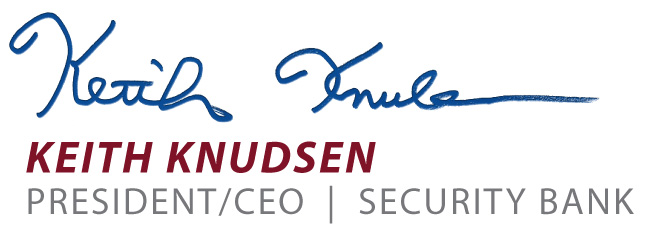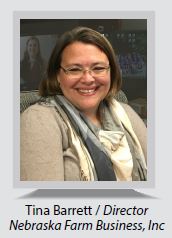
2021 Financial Analysis Summary
June 27, 2022
| AgFocus-Ag Focus
|
 With the crops in the ground, your attention shifts to many other things. One thing our attention does not, however, shift away from is trying to envision how 2022 will turn out with the high input costs, strong commodity prices, and many other things. This month's article draws some interesting comparisons from a previous period of stronger years in the farm economy that were followed by some years that were not quite as strong. With the crops in the ground, your attention shifts to many other things. One thing our attention does not, however, shift away from is trying to envision how 2022 will turn out with the high input costs, strong commodity prices, and many other things. This month's article draws some interesting comparisons from a previous period of stronger years in the farm economy that were followed by some years that were not quite as strong.

|
By Tina Barrett, Director at Nebraska Farm Business, Inc.
As seen in Cornhusker Economics May 18, 2022
 While the 2021 Average Farm Financial Data summary is not complete yet, we have enough information to start drawing some conclusions about what the numbers mean for farmers and ranchers in Nebraska. The conclusions that can be made are not only on the 2021 statistics but also on how 2021 will supply a boost to the financial health of those operations for 2022 and beyond. The preliminary average net farm income looks to be the highest recorded in the history of our data, dating back to 1976.
While the 2021 Average Farm Financial Data summary is not complete yet, we have enough information to start drawing some conclusions about what the numbers mean for farmers and ranchers in Nebraska. The conclusions that can be made are not only on the 2021 statistics but also on how 2021 will supply a boost to the financial health of those operations for 2022 and beyond. The preliminary average net farm income looks to be the highest recorded in the history of our data, dating back to 1976.
At the beginning of 2020, prior to rumors of a new virus, the cash flows we prepared for producers looked as bleak as any I have ever seen. It was not a matter of how much money operations would make but how much working capital would be burned in hopes of better things to come. I was preparing to brush off the bankruptcy tax rules as the prosperity of the years 2007-2012 was gone. For example, in 2012, the average working capital to gross revenues was 51.4%, but by the beginning of 2020, it had eroded to 21.1%. Most operations were in a position of low liquidity and the average corn price remained below the cost of production.
The following months were spent learning new laws rather than brushing up on old laws as we had to rapidly keep up with new programs from Covid. These programs were important as many of them contributed to the increased income in 2021. Programs such as the Paycheck Protection Program (PPP) were not counted as income until they were forgiven. Most of the producers included in our averages did not apply for forgiveness until 2021, which means the income was not recognized until 2021. Other programs, such as the third installment of the CFAP program received in 2021 and the Employee Retention Credit, (ERC) which was extended into 2021, would have also brought significant income to some operations. While the CFAP program was based on production to help offset market disruptions, both the PPP loans and the ERC programs were implemented to encourage employers to keep employees working.
Even though these programs are an important part of the story that is buried in the 2021 numbers, the average received from these programs is less than 10% of the average net farm income, so it’s not the most substantial part of the story. The largest part of the net farm income increase came from crop and feed inventory changes. This accounts for over 50% of the 2021 net farm income. Inventory values come from two sources: 1) bushels (or other units) and 2) price per unit. The preliminary irrigated corn average yield is 20 bushels per acre higher than the previous high and the irrigated soybean yield was best by 5 bushels per acre. This goes a long way to increasing net income. Prices were also up. Average marketing prices for the 2021 corn and soybean crops were the 3rd highest on record. When these perfect storms of high yields and prices combine, we are going to see a significant income.
The final piece of the puzzle that is important to remember about the income from 2021 is a marketing gain on the 2020 carryover crop. We prepare all balance sheets as of 12/31 (unless the operation has a different fiscal year). The value we put on inventory is either the contracted price or an average price from that day. Prices of many commodities rose from 1/1/21 until they were sold. The accrual adjustment of that increase would also be included as 2021, even though it was on the 2020 crop. We feel the best way we can get accurate, consistent numbers is to separate the marketing decision to hold the crop for later markets from the production in this way. We will see a similar income boost in 2022 as the commodity prices continue to rise after 1/1/22. It is harder to be able to separate that date on an average basis because we would need to be able to separate cash sales between old and new crops, but we saw it on almost every individual analysis and know it is a factor.
What does this mean for 2022? It is not a secret that input prices saw significant increases in 2022. The 2021 preliminary data shows a 10% increase in costs over 2020, but that will pale in comparison to the increase coming for 2022. On the other hand, commodity prices continue to hold at profitable levels, which is encouraging for the coming year.
Just as we watched the profitability from 2007 – 2012 erode from balance sheets over the past ten years, the profitability built in 2021 may need to be used to withstand future downturns. This means it is important to watch spending, especially capital purchases that are only needed to buy down a tax bill. Spending $100,000 on equipment you do not need to save $30,000 in taxes does not preserve your liquidity like paying $30,000 in taxes and having $70,000 of cash or reducing your operating note does. Controlling family living is also important. The last time we had record-setting profitability, family living costs almost doubled and they never came down. 2021 preliminary numbers do not show an increase, but it is easy to let that expense run away from itself.
2020 and 2021 have helped a lot of operations that were hurting from extended low commodity prices, but we still do not see balance sheets as healthy, especially in the liquidity area, as they were in 2012. 2022 will be an important chapter in the story of continued financial health for many Nebraska operations.